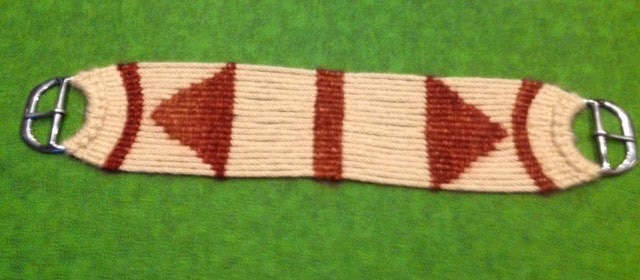A blog that focuses on our unique program that teaches natural horsemanship, heritage breed conservation, soil and water conservation, and even folk, roots, and Americana music. This blog discusses our efforts to prevent the extinction of the Corolla Spanish Mustang. Choctaw Colonial Spanish Horse, Marsh Tacky, and the remnants of the Grand Canyon Colonial Spanish Horse strain.
Wednesday, September 17, 2014
What Hand Woven Means
This was a wonderful gift I received today. It is my first mohair girth. It is also the first girth that Pam, one of our adult riders, made. Her husband, Dan, made her a loom and in short order she produced a girth.
She did it all by hand, by herself.
Several months ago Lloyd plaited me a colorful quirt and rigged my bridle with long slobber straps. I am rather sentimental about such things.
Things like this are part of what makes it worth it to be a part of this program.

Wow, I would have never guessed that was her first girth!
ReplyDeleteHeh...another addict created...See, making a pair of reins is like a gateway drug..you make one..Then decide you want a spare pair, Then a friend wants a pair..
ReplyDeleteThen pretty soon you are considering plaiting your own shoelaces.
I have been doing fancy rope work since I was a young puppy in the Navy, and have always found it to be rewarding.
In this modern, for lack of a better (well, socially acceptable anyway) term, civilization, everything is mass produced and sold dirt cheap, and everybody pays the price for it. Let's say you buy a saddle..50 or 100 years ago, almost any saddle made was an investment of a lifetime, and probably your kid's lifetime..now, it is not hard to find that quality of a saddle, but the price tag starts up around two thousand dollars..
Time was, craftsmanship was the hallmark of existence. A person was ashamed if fault was found in their work. Dedication.
Today, it seems life is too fast, a dollar is too important, and everybody has a hand out for that dollar.
In an encyclopedia of rawhide braiding that I own, there is a story of a lady who made her own rawhide, starting with a cow on the hoof and ending with beef to eat and a rope to catch the next one. Well, she made over 90 reatas in her lifetime, (A reata is a lasso made from rawhide. I have one in progress) and claims that her best one was made from the hide of her favorite horse after he passed on. Now that is dedication to the art. And highly practical. The horse was not needing it anymore. Today we waste everything it seems.
Here at Mill Swamp we work to teach some basic skills like this, not in any formal sense of the word, but through example..don't toss a bridle out because it has busted, fix it! Want new reins? Make 'em. Busted old saddle pad? Pam does a right nice job of re-quilting them.
I hope that some of these activities rub off on our little riders and become a desire to learn some obscure skills, after all, a young lady with the skill and gumption to fashion a comfortable saddle starting with not much more than a dead cow can accomplish pretty much anything she sets out to do.
That cincha is just gorgeous, Pam.
-Lloyd